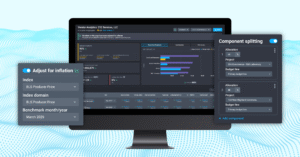A commercial real estate equity waterfall is a financial structure used to distribute cash flows from different investment partners in a real estate deal. The waterfall model can be used to show how a cash flow is being distributed among equity investors in the capital stack. Investors need to understand who gets paid first in a real estate deal because it affects their risk exposure, return potential, and overall investment security. The payout hierarchy outlined in the equity waterfall determines cash flow between all stakeholders, including lenders, limited partners (LPs), and general partners (GPs).
Here, you’ll learn the ins and outs of the equity waterfall structure and how you can leverage the cash distribution strategy in your deals:
What is an Equity Waterfall in Real Estate?
The equity waterfall is used in a real estate deal to determine the order in which the distributable proceeds of a fund are issued to commercial real estate investors. The distribution structure is often used when a fund has both sponsors who find and manage investment opportunities and passive investors who contribute funds but aren’t involved in day-to-day operations.
Profit distribution in the equity waterfall is designed to align the financial incentives of limited partners (LPs) who put up the lion’s share of funding and the general partners (GPs) who are active investors managing the deal. The underlying provisions of a fund – known as the Limited Partner Agreement – sets the conditions that must be met for parties to be entitled to proceeds on a fund. In a waterfall structure, the mechanics are played out in a series of tiers, with each tier containing a set of guidelines to allocate profits.
Key Players in an Equity Waterfall Structure
Each player in the equity waterfall structure has a unique role, level of risk exposure, and expectation for returns. Here’s a more in-depth look at the key players’ functions within the equity waterfall:
Limited Partners (LPs)
Limited partners provide most of the equity capital in a commercial real estate deal, typically institutional investors, private equity firms, or high-net-worth individuals. LPs have priority over GPs in the capital stack, often receive a preferred return, and receive a portion of profits based on an agreed-upon split in the waterfall structure.
General Partners
General partners manage and execute real estate strategy–sourcing deals, securing financing, and overseeing construction or operations. GP’s contribute a small portion of equity but take a more active role in the project and are paid last, meaning their stake in a project is higher risk. The GP is paid after an LP has been paid out as part of the CRE structure.
The Four Tiers of an Equity Waterfall Distribution
The waterfall metaphor in this equity distribution structure refers to how returns flow through the four tiers, each with specific return hurdles and allocation rules. Taking a closer look at the four tiers – Return of Capital, Preferred Return, Catch-Up Provision, and Profit Splits – helps investors and sponsors align on expectations and gain insight to assess an investment’s potential risks and rewards.
The components of equity waterfall in real estate deals can vary, but common elements include:
Return of Capital: Investors first receive payments to recover the initial capital invested.
Preferred Return (Pref): Proceeds go to the Limited Partner at a preferred return rate, typically ranging from 6-10%, before the general partners get paid
Catch-Up Provision: General partners then receive a portion to “catch up” on distributions once the limited partner reaches the preferred return Promoted Interest: Promoted interest, also known as a promote, is the outsized share a limited partner can earn if the investment exceeds return expectations. In general remaining profits will be split to prefer LPs over GPs, such as 70/30 or 80/20
Return Hurdle: The return hurdle is the benchmark of a transition from one tier to another with a different cash flow allocation, usually expressed as an internal rate of return. The more complex the real estate equity waterfall, the more return hurdles there will be in adjusting the split between LPs and GPs
Why Equity Waterfalls Matter for Investors
Equity waterfalls have clear benefits for real estate investors, helping limited partners gain a deeper understanding of returns and risks. The structure prioritizes limited partners’ returns by ensuring they recover the initial investment and earn a minimal return before sponsors participate in upside profits. At the same time, the equity waterfall ensures fair compensation for general partners who generate returns. The structure helps all parties understand the order of payouts, increasing transparency and predictability across the real estate deal.
Key Considerations in an Equity Waterfall Structure
When constructing an equity waterfall structure as part of a real estate deal, there are several key considerations you should consider:
Investor Return Preference:
Investors will have individual preferences around payout as part of the real estate deal. Some investors may want a higher preferred return rate even if it means giving the general partner a larger promote if the project exceeds expectations in terms of returns. Others may accept a lower preferred return in exchange for a larger share of cash flow.
Capital Stack Position
Investors may want to structure the equity waterfall based on capital stack position, i.e. where the investor is in preferred equity, common equity, or mezzanine debt. Since lower-tier positions (like common equity) are further down in the capital stack, senior positions are protected if the project underperforms. On the flip side, if the project overperforms, lower-tier positions see major upside.
Familiarity with Complex Financing Structures
The benefit of an equity waterfall for real estate investors is the increased transparency around how returns will be distributed to limited and general partners. However, participating parties should be well-versed in complex financing structures. Ensuring all parties understand the risks and rewards of a deal will prevent misunderstandings down the road as a deal pays out.
Market Conditions
External market conditions can impact your equity waterfall, as investors must be confident in prospective returns to provide funding. Be aware of the impact of potential market headwinds or the interest rate environment might have on a project before entering an equity deal.
How to Evaluate an Equity Waterfall in a CRE Deal
There is no one-size-fits-all structure for a real estate equity waterfall. When evaluating the terms of an equity waterfall in a real estate deal, you should analyze return projections and promote structures to get more insight into what repayment will look like over the course of the project’s lifecycle.
Evaluate Return Projections and Promote Structures
Be sure to evaluate return projections in an equity waterfall to make sure you understand how returns will be generated and who in the financial structure will get the most of the profit. Investors can look at the Internal Rate of Return, Equity Multiple, and Cash-on-Cash return. You can also compare base case, downside, and upside scenarios to make sure the deal still yields returns with different project outcomes. A good structure allows the sponsor to profit after the investor makes strong returns.
Investor-Friendly vs. Sponsor-Friendly Waterfalls
Strong return projects may not mean much to investors if the deal is overly friends to the sponsor. Investors should look to make sure the promote structures offer performance incentives for sponsors after investor capital is protected and base returns are delivered.
Understanding who gets paid first in a real estate equity waterfall structure is fundamental for investors to make informed decisions. Investors who have a knowledge of the equity waterfall structure, and who can evaluate the risks and benefits in any scenario, will have a leg up in their commercial real estate deals. Be sure to carefully analyze waterfall terms before investing in a development deal, and ensure the structure lends itself to your organization’s financial goals.
Book a demo and find out how Northspyre helps developers lower costs and increase returns across the lifecycle of a project.



